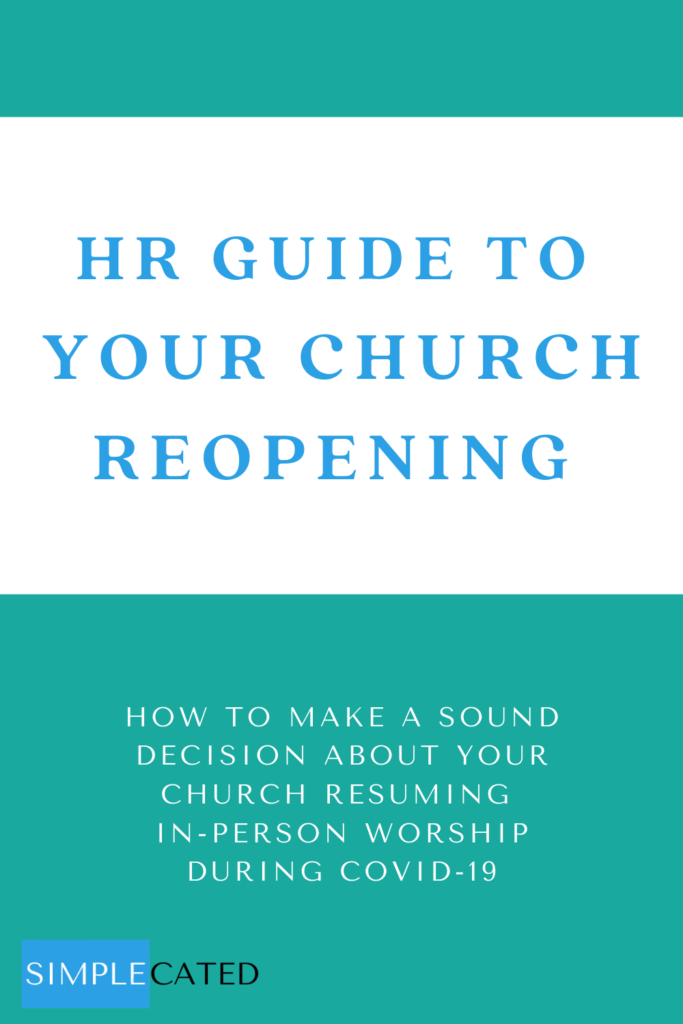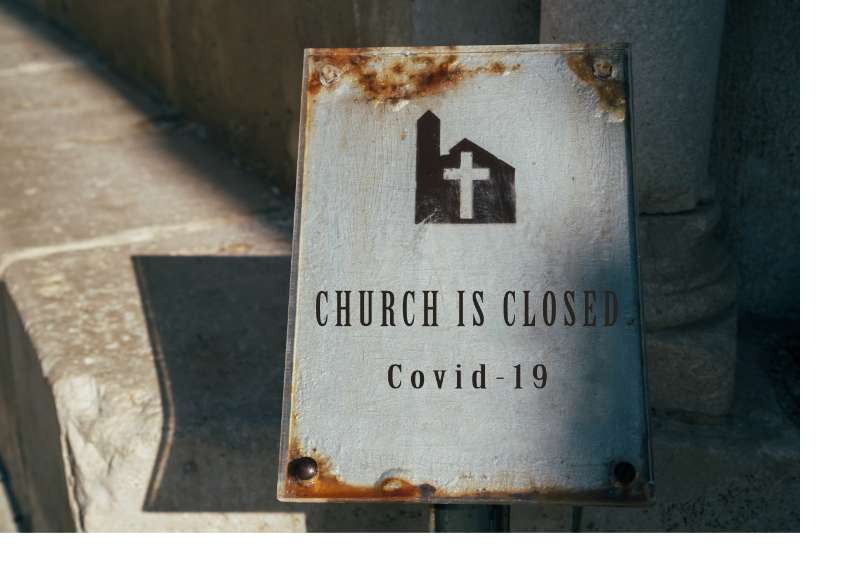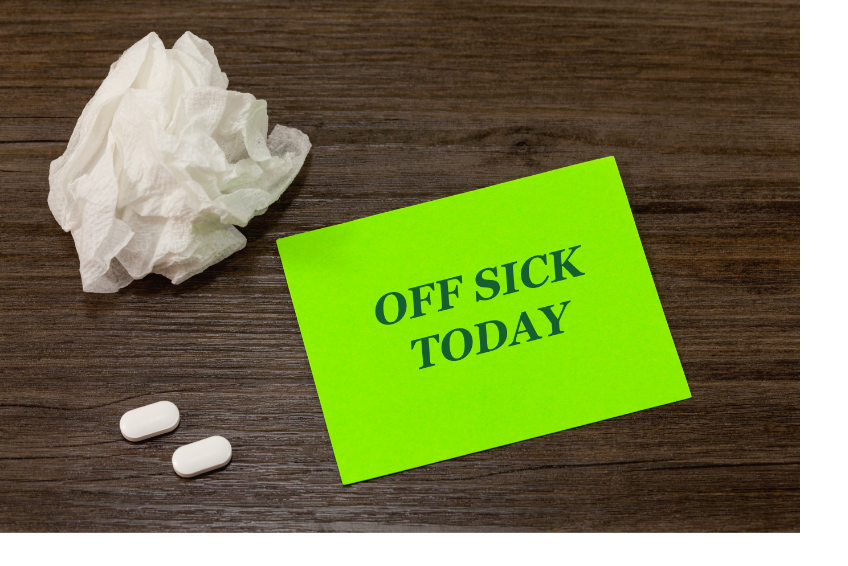Can you believe it’s been almost 1 year since the COVID-19 shutdown began? To me, it seems like a lifetime ago that we could get together in huge groups without a care in the world. Many churches are still broadcasting worship services solely online. As the weeks have grown into months, however, more and more churches have started at least a partial reopening. That means pressure may be mounting for those of you who haven’t yet resumed in-person worship. Back in August, a survey of Protestant pastors showed that 27% were concerned about maintaining congregational unity (up from 8% in April) and that conflict related to the pandemic was a “top pressure point.” I think it’s safe to say that number has increased by now! And, with Easter coming up, that pressure is likely to keep growing. If you’re considering your church reopening, what are the top things to take into consideration?
Everyone has their own personal opinions about what should or shouldn’t matter. Some talk about their religious perspectives or even their political perspectives. I’m going to focus on the HR perspective. After all, worship services are an aspect of your workplace. Ensuring the safety and wellbeing of everyone should be a top priority. There are so many feelings about the topic of reopening churches that it can seem like you’re wading through mud. Viewing the decision from an HR perspective can simplify the debate and help you focus on what’s most important. Ultimately, it can help you make a sound decision you can feel confident about and can easily explain to others. Here are 3 questions to ask yourself.
What need(s) are you trying to meet by reopening?
Almost every church-attending person I know wants to be able to have in-person worship. So, this isn’t about wanting or preferring to be in-person. This is about why you need to reopen during a pandemic. I encourage you to be very honest with yourself. Get down to the root of the real problems you’re trying to solve. Is tithing getting lower and lower? Are powerful people putting on the pressure and you’re afraid you might lose your job? (I’ve even heard of congregants threatening to withhold tithes if the decision doesn’t go their way!) Is your congregation not engaging online? Are you unable to do online services? Are many attendees unable to participate online?
Once you determine the needs you’re trying to meet, you can better evaluate how much reopening will help. In some cases, there may be other options. Remember, a weekly worship service is probably just one aspect of all that your church offers (or could offer). From that standpoint, just because you don’t worship in-person doesn’t mean your church is “closed.” So, for example, if many of your attendees are elderly and unable to participate online, maybe you consider the possibility of a Zoom group or very small get-togethers to help them avoid loneliness. If tithing keeps getting lower, it may be time to start talking transparently about that. Make sure there are easy ways to give and that your congregants understand where their money is going.
You may still decide to reopen, but knowing the variety of options that exist can help you evaluate this decision. After all, we have two more questions to ask ourselves!
How does your staff feel about reopening?
This is very important. Get your staff together, and find out how everyone feels about the idea of reopening. (You might need to involve committees as well depending on how your church operates.) Having a variety of perspectives can help you see any blind spots you may have overlooked. It may be that some elements could work while others wouldn’t yet. Often, a worship service is just one part of weekly in-person programming. You also have childcare, Bible study for some/all ages, and various ministries that are involved in these programs. Put everything on the table, and get feedback from your staff.
Keep in mind that you might have some staff who are considered high-risk and could be uncomfortable with reopening. There can be a lot of reasons for employees to be concerned about being onsite with others, so be prepared for those conversations and be understanding. Find out if there’s anything that would help them be more comfortable. If it’s likely you’ll be reopening, talk with them about what they can do to participate. Maybe they record their part ahead of time, or maybe they focus behind the scenes. Ask them to come up with suggestions so that they are still performing the essential elements of their jobs – just maybe in some unique ways. This is a time to think outside the box!
If you find that most/all of your staff is uncomfortable with your church reopening and there aren’t any good solutions, then I’d think strongly about postponing. Involve them in finding other ways to meet the needs you identified in question 1. This is a time for everyone to shoulder the responsibility together.
Can you ensure everyone’s safety and wellbeing?
It’s possible that questions 1 and 2 went pretty quickly for you. Heads up – this one will take some time, and it will require your entire staff. So, grab another cup of coffee.
Ensuring the safety and wellbeing of everyone who walks through your doors must be a top priority. One, because it’s the right thing to do! Two, because you’re an organization and a workplace. Safety and wellbeing are important anyway – it’s just that now we’re so very aware of that.
First, think about your workplace COVID protocols. What do you do to keep your staff safe? Hopefully, it involves requiring on-site employees to wear masks and socially-distance, following CDC guidelines about cleaning, and having staff stay home when sick or exposed (ideally with paid sick leave). Whatever you do for worship services is a part of the workplace, so these protocols need to extend. If you’re showing services online, you’re implementing these protocols with anyone who comes onsite to broadcast the services. If you’re in-person, you’re determining how to extend these protocols to everyone who walks through the doors.
The CDC has a great list of recommendations for church gatherings, so that’s a good place to start. This will help you think through whether you could reopen your church safely and what it would take to do so. When it comes to practicalities, here are some protocols to consider:
- Masks are mandatory. Consistent with CDC guidelines, masks are mandatory over age 2 – the whole time. If someone has a health condition that prevents them from wearing a mask, they can talk with you to find a solution. This isn’t the time for politics – this is about safety and wellbeing. You know if you’ll have difficulties with any members over this topic. This post about how to talk with employees who don’t want to wear masks can help prepare you for these conversations. Keep in mind that church leaders must set the example. If you require masks but the senior pastor never wears one, that’s a problem. When someone goes up to the microphone, mask can come off. Leave the microphone, and mask goes back on. Keep it simple!
- No food and beverages. I love being able to bring coffee to church. But not during a pandemic. If you tend to offer food or beverages for worship services, discontinue that for now. It’s way too risky, leads to a ton of sanitation needs, and messes with your mandatory mask policy.
- Social distance. People from different households need to remain 6 feet apart. This means seating options need to be arranged accordingly. Maybe you mark off every other pew and have people sit on designated ends. Have ushers available to assist with this. The “6 feet apart” rule applies the whole time, so no handshake greeting time, hugs, etc.
- Outside is ideal. Depending on the season and your location, outside venues are ideal. Ventilation is much better, and people can spread out easily. If you can’t be outside, consider whether you need to limit inside attendance in order to follow CDC guidelines.
- COVID symptom checks. Temperature checks are a part of life now. If you’re about to have a group of people together in a building, temperature checks should happen. Most people in your congregation will probably have good intentions of abiding by the CDC sick/exposure guidelines, but you’re responsible for ensuring a safe environment for everyone. It’s not wise to solely rely on others’ intentions. Conduct temperature checks and do a symptom check. It can be as quick as having them listed on a big sign by the door and asking each person if any of these apply.
- No bulletins or shared hymnals. The goal is to limit contact with others (and the amount of items you’ll need to clean). People only need to handle what they brought. So, bulletins don’t need to be passed out or hymnals shared. Remove pens and offering envelopes from the pews. This means offering time might need to look different for you too. Have congregants place offerings at a designated spot so you can safely handle them later.
- Sanitize, sanitize, sanitize! Have hand sanitizer available right inside the building and anywhere else that seems applicable. Do a thorough cleaning of all used spaces after worship. To this point, limit the amount of your building that’s used to only what’s necessary. This limits the amount of sanitizing you’ll have to do later.
- Be prepared for contact tracing and communication. Make it clear to your attendees that they need to notify you if they test positive for COVID (or have COVID-like symptoms) and may have exposed others at a church event. Do as much contact tracing as you can, which may not be a whole lot depending on the size of your church. Most likely, you’ll need to send out a communication to everyone notifying them of a possible exposure (maintaining the confidentiality of the individual).
Decision Time!
The decision you make now doesn’t have to be forever. If you decide reopening isn’t necessary or possible right now, remember that’s a temporary decision. Hopefully, that can encourage you and your congregation! Keep evaluating, and you’ll be able to determine when it’s the right time. (Remember, just because you don’t resume in-person worship doesn’t have to mean you’re “closed.”) If you decide to reopen, remember that can be a temporary decision too. I’d recommend a partial reopening so you can practice the protocols and then increasing size as you’re able. Keep evaluating your ability to ensure the safety and wellbeing of others. Many churches have reopened and then had to return virtual for a time period, so be flexible.
By asking yourself these questions and following appropriate guidelines, you’ll be able to make a sound decision about your church reopening for in-person worship. In the process, you’re helping your church to demonstrate to each other and the community that you truly do care about the safety and wellbeing of others. That’s a hugely important message for the church to send, don’t you think?
What is your church doing for worship services? Comment below!
Photo credit: By IB_photo / Canva





